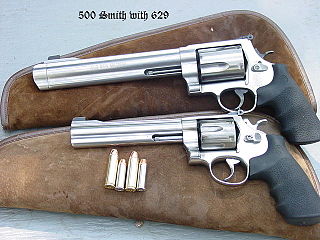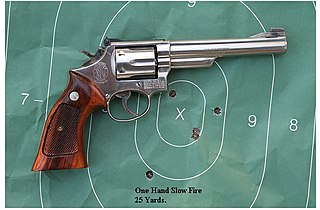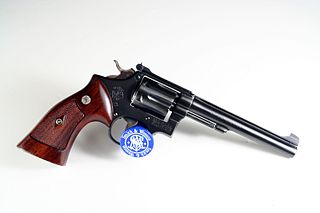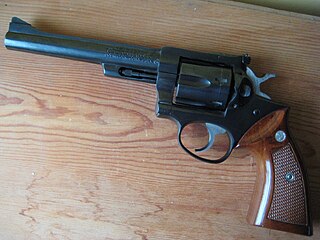
A revolver is a repeating handgun that has at least one barrel and uses a revolving cylinder containing multiple chambers for firing. Before firing a round, cocking the hammer partially rotates the cylinder, indexing one of the cylinder chambers into alignment with the barrel, allowing the bullet to be fired through the bore. The hammer cocking can be achieved by either the user manually pulling the hammer back, via internal linkage relaying a rearward movement of the trigger, or both. By sequentially rotating through each chamber, the revolver allows the user to fire multiple times until having to reload the gun, unlike older single-shot firearms that had to be reloaded after each shot.

Smith & Wesson Brands, Inc. (S&W) is an American firearms manufacturer headquartered in Springfield, Massachusetts, United States.

The Colt Single Action Army is a single-action revolver handgun. It was designed in 1872 for the U.S. government service revolver trials of 1872 by Colt's Patent Firearms Manufacturing Company and was adopted as the standard-issued pistol of the US Army in 1873 until 1892.

The Mateba Model 6 Unica is a recoil operated semi-automatic revolver, one of only a few of this type ever produced. It was developed by Mateba, based in Pavia, Italy. Inventor Emilio Ghisoni (1937–2008), who was also famous for later designing the Chiappa Rhino, is listed as the owner of U.S. Patent 4,712,466 which details the operation of the weapon. International produced and manufactured.

The Smith & Wesson Model 500 is a five-shot, double/single action large-caliber revolver produced by Smith & Wesson, firing the .500 S&W Magnum cartridge.

The Smith & Wesson Model 19 is a revolver produced by Smith & Wesson that was introduced in 1957 on its K-frame. The Model 19 is chambered for .357 Magnum. The K-frame is somewhat smaller and lighter than the original N-frame .357, usually known as the Smith & Wesson Model 27. A stainless steel variant of the Model 19, the Smith & Wesson Model 66, was introduced in 1971.

H&R 1871, LLC, or more commonly known as Harrington & Richardson, is an American brand of firearms and a subsidiary of JJE Capital Holdings. H&R ceased production February 27, 2015.

The Smith & Wesson Model 17 is a six-shot double-action revolver chambered for .22 LR. It is built on Smith & Wesson's medium-sized K-frame.

The Ruger Blackhawk is a six-shot, single-action revolver manufactured by Sturm, Ruger & Co. It is produced in a variety of finishes, calibers, and barrel lengths.

The GP100 is a family/line of double action five-shot, six-shot, seven-shot, or ten-shot revolvers made by Sturm, Ruger & Co., manufactured in the United States. Since its introduction, it has been produced with a number of variations including various barrel lengths and profiles, fixed or adjustable sights, and in blued carbon steel or stainless steel.

A snubnosed revolver is a small, medium, or large frame revolver with a short barrel, generally less than 4 inches in length. Smaller such revolvers are often made with "bobbed" or "shrouded" hammers and there are also "hammerless" models ; the point is to allow the gun to be drawn with little risk of it snagging on clothing. Since external movement of the mechanism is minimal or nil, shrouded and hammerless models may be fired from within clothing. The design of these revolvers compromises range and accuracy at a distance in favour of manoeuvrability and ease of carry and concealment.

The Ruger Redhawk is a DA/SA, large-frame revolver that was first introduced in 1979 by Sturm, Ruger & Company. Made from high-grade steel, it is available in a stainless steel finish. The Redhawk is reinforced to handle extra stress, making it very popular for use by handloaders as it is able to handle both .45 Colt and .44 Magnum loads. In addition, the cylinder itself is longer than most competitors', allowing ammunition to be loaded to a longer overall length. This allows for either increased powder capacity, heavier bullets without compromising the powder load, or a combination of both. Custom ammunition manufacturers even have loads made specifically for Ruger revolvers that cannot fit in shorter chambers or revolvers of weaker construction. This makes the Redhawk popular as a bear defense gun among hunters and trappers.

S&W Centennial is a family of revolvers made by Smith & Wesson on the "J-Frame". Depending upon caliber, the cylinder holds either 5, 6, 7, or 8, cartridges. Centennials feature a fully enclosed (internal) hammer, which makes them Double Action Only (DAO) firearms. Like all other "J-frame" Smith & Wesson revolvers, they have a swing-out cylinder. Centennial models have been made in different versions like PD "Personal Defense", LS "Lady Smith", and M&P "Military & Police"

A handgun is a short-barrelled firearm that can be held and used with one hand. The two most common handgun sub-types in use today are revolvers and semi-automatic pistols, although other handgun-types such as derringers and machine pistols also see infrequent usage.

The Smith & Wesson Model 60 revolver is a 5-shot revolver that is chambered in either .38 Special or .357 Magnum calibers. It was the first revolver produced from stainless steel.

The Colt Trooper is a medium frame, double-action revolver featuring a six-round cylinder, chambered for .22 Long Rifle, .22 Winchester Magnum Rimfire, .38 Special, and .357 Magnum caliber cartridges. Designed as a less expensive alternative to the upscale Colt .357 and the later Colt Python and Colt King Cobra, it was marketed to law enforcement agencies as well as civilians.

The Smith & Wesson Model 57 is a large frame, double-action revolver with a six round cylinder, chambered for the .41 Magnum cartridge, and designed and manufactured by the Smith & Wesson firearms company. The gun was designed as a weapon for law enforcement agencies. However, due to size and recoil it found more favor with civilian target shooters and hunters.

The Ruger Security-Six and its variants, the Service-Six and Speed-Six are a product line of double-action revolvers introduced in 1972 and manufactured until 1988 by Sturm, Ruger & Company. These revolvers were marketed to law enforcement duty issue, military, and civilian self-defense markets.

The Smith & Wesson Bodyguard is a family of small J-frame revolvers with shrouded hammers manufactured by Smith & Wesson. They are available chambered in either .38 Special or .357 Magnum.
Richard J. Casull was a Salt Lake City-born gunsmith and wildcat cartridge developer whose experiments with .45 Colt ammunition in the 1950s led to the creation of the .454 Casull cartridge. Casull's passion was six-shooters, and he was determined to create a high velocity round for the .45 Colt. His goal was to achieve a muzzle velocity of 2,000 feet per second with Colt .45 rounds fired from a single-action Army-style revolver with a 7+1⁄2inch barrel. This proved impossible due to the tensile strength of the Colt .45 cylinder, so he set out to develop his own casing and bullet.





















